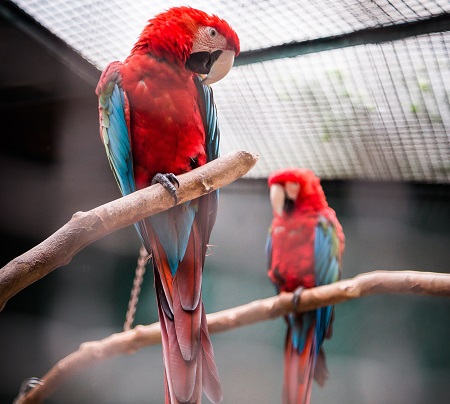
When shopping for perches consider safety, variety and how well the perch will hold up under use. A different variety of sizes are important in helping keep a pet bird’s feet exercised and healthy. It is not healthy for a bird’s feet to be constantly clutched in the same position, which will happen if he is using perches of only one size or shape. A perch that can be totally encircled by a bird’s foot so that his toes overlap is too small. A bird should be able to get his foot at least three-quarters of the way around the perch. Birds tend to chew on their perches, so make sure the perch isn’t too soft to be easily destroyed. If a perch is being chewed up and becoming worn, replace the perch before the bird swallows some of the perch material.
Types of Perches
Plastic
Plastic Perches come in acrylic and PVC, and both are easy to clean and sturdy. Acrylic perches are hard to destroy, PVC can be chewed and swallowed, which can be dangerous for your bird. They can be slippery and uncomfortable and plastic is not a natural perch for a bird, which may cause some foot problems. Wooden perches most closely follow what a bird would perch on in the wild.
Wood
Wood perches can be purchased already made, in a variety of sizes and complete with hangers. If you have access to willow, birch or fruit trees, branches from these trees make ideal perches. They come in all sizes and interesting shapes and won’t cost a penny. It’s a good idea to have several natural perches for your birds and to change them from time to time in the cage. This helps the bird exercise its feet and relieves some boredom. Do not use branches from trees that have been sprayed with any kind of insecticide or pesticide or any other plant/tree that may be poisonous to birds.
Mineral
Mineral perches are also called concrete or cement perches. They helpful in wearing down the nails and beaks of birds, preventing them from becoming overgrown. These perches are also comfortable and relatively indestructible. Almost every bird should have one mineral perch. The use of sandpaper perches is not recommended. The sand on them may cut a bird’s feet or cause other feet problems.
Rope
Most birds like to sit on rope perches. It has a good feel for their legs and feet and provides a solid footing for them. Purchase a stiff rope coil. Do not use a rope that will fray or be chewed easily. If the rope perch ever does become frayed, replace it immediately. Birds can swallow bits of rope and even get their claws stuck in a fray.
Did You Know
Flamingos are pink because shrimp is one of their main sources of food.
The flying frog uses flaps of skin between its toes to glide.
The slowest mammal on earth is the tree sloth. It moves at a speed of 6 feet per minute.
The Cassowaries are the world’s most dangerous birds, capable of dealing fatal blows. They are very unpredictable, aggressive creatures, especially if wounded or cornered. The Cassowary lives in the rain forests of Australia and New Guinea and are shy animals if undisturbed, but if you get too close and it thinks you’re a threat you could receive a bone-breaking kick or get sliced by its dagger-like sharp claws.
Female chickens, or hens, need about 24 to 26 hours to produce one egg. Thirty minutes later they start the process all over again. In addition to the half-hour rests, some hens rest every three to five days and others rest every 10 days. A typical hen lays 19 dozen a year.
The left leg of a chicken in more tender than the right one.
Related Articles & Free Email Newsletter Sign Up
How to Avoid Malnutrition in Pet Birds
How to Identify & Eliminate Depression in Pet Birds


Comment here